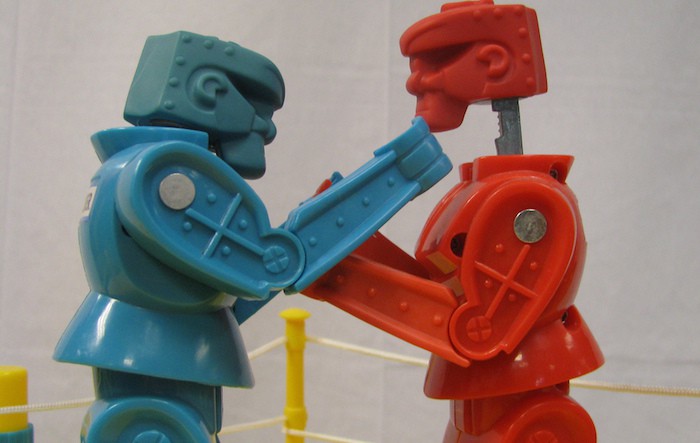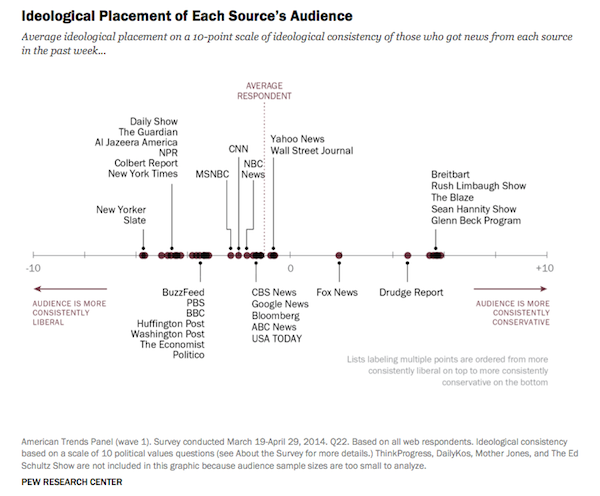
Strong liberals and strong conservatives disagree on an awful lot — but there are a lot of ways they’re more like each other than they are like those closer to the middle. And some of those involve the ways they interact with news media.
That’s one of the takeaways from a new report from the Pew Research Center on how ideology and political polarization intersect with media consumption habits. The study, “Political Polarization & Media Habits,” looks at how the news Americans consume and the outlets they follow help to shape or reinforce their political outlook. The report is based on an online survey of almost 3,000 Americans and divides them into five ideological groups based on how they responded to issue questions: consistently liberal, mostly liberal, mixed, mostly conservative, and consistently conservative.
The large role Fox News plays for conservatives is very clear in the data: 47 percent of a group Pew identifies as “consistent conservatives” say Fox News is their main source of information on government and politics. “Consistent liberals” rely on a mix of sources including CNN (15 percent), NPR (13 percent), MSNBC (12 percent), and The New York Times (10 percent). Pew also found that 44 percent of consistent liberals on Facebook claim to have blocked, hidden or unfriended someone whose posts they disagreed with, compared to only 31 percent of consistent conservatives and 26 percent of all Facebook users.
On their face, these findings might seem to lend support to the idea that we’re becoming a country of smaller and smaller filter bubbles, personalized universes of news and people that fit our own interests. But the connection between how Americans get news and their political polarization is not black and white. Pew found that on Facebook, the majority of people only see political posts they agree with some of the time. That’s also reflected in the real world, as Pew found people on all ends of the political spectrum tend to get a mix of dissent and agreement on politics in their every day life. 58 percent of consistent liberals and 45 percent of consistent conservatives say they often get agreement and disagreement in their conversations on politics. For people with mixed political views — Pew’s middle ideological category — that jumps up to 76 percent.The study also suggests that in America today, it is virtually impossible to live in an ideological bubble. Most Americans rely on an array of outlets — with varying audience profiles — for political news. And many consistent conservatives and liberals hear dissenting political views in their everyday lives.
There might also be broader ideological diversity in the audience than some expect. While conservatives favor Fox News as their main news source, and people on the right make up the biggest proportion of the channel’s viewers, Pew found that less than half of people who watch Fox News in a week are conservatives.
The full report is now available from Pew, but here are a few things that caught our attention:
Many of the choices of outlets were consistent across ideological lines; local television was a top-3 source in every group, for instance. But other habits lined up as stereotypes might suggest: Liberals over-index for NPR, conservatives for Fox News. Liberals like The Daily Show, conservatives Sean Hannity.

In looking at how news consumption ties to ideology and polarization, the Pew survey included 36 specific news outlets (plus “local TV” as a 37th) crossing over from print to digital and broadcast, including the major cable and broadcast news shows, papers like The New York Times and The Washington Post, as well as international outlets like the BBC and The Guardian and digital news sites like Politico, The Huffington Post, and BuzzFeed.
While conservatives tend to rally around Fox News as their main sources of news, the survey found that consistent liberals use a wider number of news sources — 6.7 sources — than people of other political ideologies. Consistent conservatives use 5.4 sources, according to Pew. The farther one gets from the ideological middle, the more news sources one uses: Those in the middle used only 4.5 sources.
Whether you trust a news source depends heavily on your political perspective — those farther to the right trusted less often. Consistent conservatives express more distrust than trust of 24 of the 36 outlets Pew looked at; consistent liberals expressed more trust than distrust for 28 of the 36.
81 percent of consistent liberals distrust Fox News, while 75 percent of consistent conservatives distrust MSNBC. Sources most trusted by consistent conservatives — the radio shows of Rush Limbaugh, Glenn Beck, and Sean Hannity, for example — are among the most distrusted by consistent liberals.
But levels of trust also related to how familiar those surveyed with a particular outlet. Places like NPR, The New York Times, and CNN are more trusted than distrusted, which also correlates with Pew’s survey group knowing the media companies. The Times was recognized by 86 percent of the group: 34 percent said they trust it, 17 percent said they did not, and 35 percent said they didn’t trust or distrust it. Other were less known to the groups. The report notes:
Outlets currently occupying more niche markets, such as Politico, the Economist or BuzzFeed, are known by only about a third of respondents. Thus, while they may elicit strong views in one direction, the share of respondents weighing in is relatively small.
The Wall Street Journal was the only outlet trusted more than it was distrusted by every ideological group. BuzzFeed was the only one each group distrusted more than it was trusted — though the numbers were small, with big majorities of every group saying they either weren’t familiar with the site or had no particular opinion about its trustworthiness.
By looking at the audiences of the news outlets in the study ,Pew was able to place them on an ideological spectrum. This is the type of thing bound to make old school editors tear their hair out; even though it’s measuring audience ideology rather than newsroom ideology (or content), it’s the sort of thing that’s easy to turn into a media bias discussion. But it’s revealing: While we may think of Fox News and MSNBC as the two poles of media ideology, their audiences are both relatively middle-of-the-road compared to those of outlets new (The Blaze, Breitbart, and Hannity, whose audiences all skew right) and old (The New York Times, NPR, and The New Yorker, whose audiences all skew left).

People who are tuned into political news tend to act as information nodes. To put it another way, if you’ve got that one friend who’s into politics, there’s a good chance he’s really into politics — and he lets others know it. This is not unlike what Pew has found on social networks, where certain power users help boost the spread of news. Pew found that diehards tend to lead political conversations, with 39 percent of consistent conservatives and 30 percent of consistent liberals driving discussion. So it’s probably not a surprise those same groups says they often lead conversations about politics — 61 percent of consistent conservatives and 57 percent of consistent liberals — and regularly have others who come to them for information on politics.
But the data also shows there are differences in social media usage along ideological lines. Those in the middle of Pew’s ideological breakdown got news on Facebook most often — 53 percent of them in the past week, higher than both consistent liberals (49 percent) and consistent conservatives (40 percent). But while those in the middle may get their news there, those on either end of the spectrum are more likely to shape their Facebook experience with politics in mind. They’re more likely to “like” or follow an issue-based group (60% of consistent liberals and 46% of consistent conservatives, versus 33% of those in the middle). They’re also more likely to follow a political party or elected official there (42 percent of consistent liberals and 49 percent of consistent conservatives, versus only 29 percent of Facebook users as a whole).
Twitter, again, had a smaller audience, but one with a wider ideological gap: 13 percent of consistent liberals got news from Twitter, compared to just 5 percent of consistent conservatives. In each of these cases, it’s hard to tease out how much of the ideological differences may be demographic differences: Younger people tend to be both more engaged on social networks and more liberal on average.